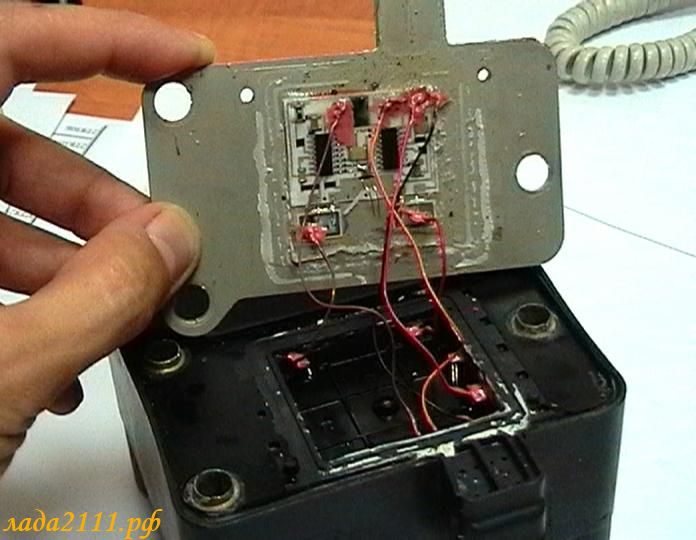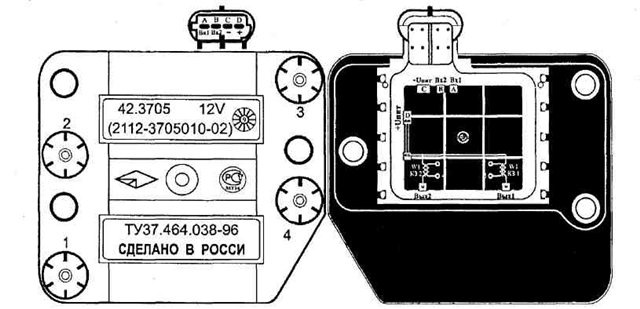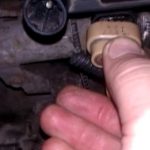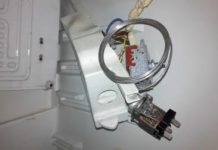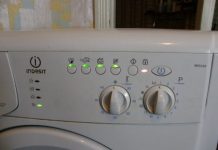In detail: do-it-yourself repair of the vaz 2112 module from a real master for the site my.housecope.com.
When operating a VAZ 21102 car, after 15,000 km. run, I suddenly discovered a strange malfunction: - from time to time, high voltage disappeared on the 2nd and 3rd cylinders. All suspicions immediately fell on the ignition module.
When inspecting it "on the go" it was noticed that if you press on the rear aluminum plate, the engine started to work normally. It would seem that everything is clear, the ignition module is dead, you need to go buy a new one, but the price bites painfully.
It was decided to carry out "trepanation" and study, so to speak, the material part of the above-mentioned miracle of the automobile industry.
Take a screwdriver and tear off the aluminum plate.
That's it, done, what do we see there. Small printed circuit board with electronics. The board is covered with a thick layer of transparent silicone, which was carefully removed by us. So, the wires by which the board is connected to the contacts of the connectors and coils are made of soft aluminum or some other metal. “So this is where my death lurked. ”- these wires are rather flimsy and tear almost at a glance.
So during the autopsy, we successfully tear off all the wires from all contacts. Well, now let's get down to business. For repair we need
thin wires, preferably stranded. The wires from the broken "mouse" came in handy for this role. As I said, remove the transparent silicone as well as the remnants of the white auto silicone.
In the meantime, let's take a look at our "giblets".
As you can see from the photo, the circuit consists of two L497D1 switches from SGS-THOMSON and two powerful BU931 transistors.
When soldering, it turned out that the contacts on the module are made of aluminum and soldering their business is not for the faint of heart, so it was purchased
special flux for aluminum.
| Video (click to play). |
The desoldering technology is as follows:
- first we solder the wires to the board. Moreover, it is advisable to remove the old wires from the board, although they are tinned better. Soldering the wires to the collectors of the transistors caused a particular difficulty - they are covered with some kind of metal that is difficult to solder. The bur-machine helped to strip the plaque of this metal to copper, but that's not all. When touched with a soldering iron, its heat was instantly dissipated on the aluminum plate. In order to properly solder, I had to put the entire plate on the electric stove and heat it up to 180 degrees.
- then we solder the wires of the board to the corresponding contacts in the “womb” of the module, trying to make the wires as short as possible.
- we cover the soldering points with some kind of varnish (I secretly took nail polish from my wife)
The result should be something like this.
It is advisable to conduct general tests of the device for its performance before final assembly. THE MAIN RULE WHEN CONDUCTING THE TEST: - TREAT WITH YOUR FEET IN THE SIDE OF THE EXPLOSION, THE AUTOMATIC UNDER YOURSELF TO DO NOT MELT :-)). If the device has shown its efficiency, then having coated the inner surface with auto-sealant, we produce the final assembly by tucking the wires inside the cavity so that they are not clamped by the plate to the edges of the cavity. Well, if the device does not work, then you will have to look for the malfunction more carefully. Perhaps this is a failure of electronic components, an open circuit or short circuit in the coils.
In conclusion, for the "folk crazy" I want to say that the L497D1 switch costs about $ 3, the BU931 transistor - about $ 6.
You can try to replace the transistor with the domestic KT848A, it is much cheaper, but its SIZES are impressive.
Hello everyone! My name is Mikhail, now I'll tell you a story about how I managed to exchange a dvenashka for a 2010 Camry.It all started with the fact that I was wildly annoyed by the breakdowns of the two, like nothing serious broke down, but the little things, damn it, so many things that really started to enrage. Here the idea was born that it was time to change the car to a foreign car. The choice fell on the tayet Camry of the tenths.
First you need remove the ignition module VAZ 2110 (instruction).
If the cause of the malfunction was not in bad contact, then you will have to look for the cause elsewhere, or replace the ignition module with a new one.
In conclusion, it will be useful for experienced electricians to know that the L497D1 switch costs about $ 3, the BU931 transistor - about $ 6.
The transistor can be replaced with the domestic KT848A, it is cheaper, but its dimensions are much larger.
In order to get rid of constant fines from cameras, many of our readers successfully use Special Nano Film for numbers. Legal and 100% reliable way to protect yourself from fines. Having familiarized ourselves and carefully studying this method, we decided to offer it to you as well.
In order to get rid of constant fines from cameras, many of our readers successfully use Special Nano Film for numbers. Legal and 100% reliable way to protect yourself from fines. Having familiarized ourselves and carefully studying this method, we decided to offer it to you as well.
In any car, including the VAZ 2112, the ignition module performs one of the main functions in the ignition system (SZ) as a whole. Thanks to this unit, the optimal start of the motor is carried out, as well as its normal operation in the future. You can learn more about device malfunctions, as well as its replacement, from this material.
Before we talk about testing and replacing MZ in our VAZ 2111, let's figure out the basic information. First, we suggest finding out what the 2111 ignition module is and where it is located.
As mentioned above, the MZ is one of the main devices in the ignition system. Of course, if you think about it, then all the components of the system are very important, since the quality of the power unit as a whole depends on them. But if this unit starts to work intermittently, then at least two cylinders, or even all four, will stop working in the engine. This is due to the fact that the module itself consists of two coils, with one of them supplying current to the first and fourth cylinders, and the second to the second and third. Accordingly, if one coil fails, it will lead to the fact that two cylinders will be inoperative, which will affect the operation of the motor as a whole.
The purpose of this device is that it converts the voltage supplied from the chopper into a high voltage signal. This impulse is accordingly applied to the cylinder plugs in a specific order. It is used to ignite the combustible mixture in the cylinders of the engine, which contributes to its normal starting and operation.
As for the location, it is not difficult to find the VAZ 2112 16 valve ignition module, it is located in the engine compartment. Open the hood and look at the spark plugs - they connect high voltage wires that go directly from the module itself. The MZ itself is a small black square box, so you cannot confuse it with anything else.
Only diagnostics will allow you to accurately determine the malfunction of the module, but there are indirect signs that can inform the car owner about a problem in the operation of the device.
In the event of a malfunction of the MH, an error is displayed on the dashboard.
So, in what cases is it necessary to replace or repair the VAZ ignition module:
- Starting the powertrain has become more difficult. The driver now needs to turn the starter more to start the engine.
- Engine idling has become erratic. The motor can be triple, while the speed can increase and decrease.
- The power of the power unit as a whole has decreased. When you press the accelerator pedal, the car needs more time to accelerate. This symptom is especially evident when moving uphill. Also, when you press the gas pedal, dips can be observed - the driver presses on the gas, but there is no effect from this.
- Fuel consumption has increased. Of course, it will be problematic to determine such a malfunction without a fuel consumption meter. But if you are used to refueling a certain amount of fuel for a certain mileage, then you can also recognize this sign (the author of the video is the Auto_Repair channel).
All these symptoms, as mentioned above, are indirect, since they can also appear with other malfunctions. For example, if the fuel filter is clogged or its service life has come to an end. Also, such signs appear as a result of wear on spark plugs or high-voltage wires. Therefore, if you are faced with such a problem, then first of all, you should diagnose the condition of the spark plugs, make sure that there is no carbon deposits on them, and also check the armored wires. It happens that one of the wires is simply poorly connected to the candle, or it is broken or worn out.
There are several options for checking the device with your own hands at home, we will consider the simplest one.
To make an independent diagnosis, you need to know what the wires connected to the module are responsible for:
- red-blue - provides 12-volt power to the device;
- the brown wire is a mass, it is usually connected to the car body;
- white-blue - connects to the spark plugs of the first and fourth cylinders;
- the red-gray wire connects to the spark plugs of the second and third cylinders.
First, you need to check with your own hands that all pulses are supplied to the ignition device 2112:
- First of all, you need to turn off the ignition and disconnect the connector.
- Further, the key in the lock must be set to position I.
- Now you need a dial-up voltmeter, it must be connected to the negative terminal of the battery.
- With the second probe, that is, a plus, you need to find the 12-volt contact on the connector.
- When connected to a control contact, the arrow on the tester will show almost 0.
- If the starter unit starts to work, the parameters may increase, but at the same time they will be no more than 0.7 volts. Note that the voltage level must be the same on both control pins.
There is another check option - you can diagnose the module's performance using a dial-up ohmmeter. In this case, it is a pointer tester that is meant, and not a digital one. First, you need to connect the device probes to pins 1 and 4 of the module, and then to pins 2 and 3. In the end, the diagnostics should show the same result.
Please note that depending on the manufacturer, these parameters may differ:
- for devices manufactured by ATE-2 with the number 3705010-02, this parameter should be about 5-6 kOhm;
- for SOATE modules with the number 3705010-12, the diagnostics should show 12 kOhm.
If the obtained indicators differ from those described above, then the module must be replaced. Please note that the inductance of the coils installed inside the MV is quite high, respectively, by connecting an ohmmeter, a spark can slip through. Therefore, when diagnosing, we strongly do not recommend touching the leads of the probes at the same time (the author of the video is HF Autoelectrician).
If checking the VAZ 2112 ignition module showed that the device needs to be replaced, then you can change the MZ with your own hands.
The replacement process looks like this:
The cost of the device directly depends on the manufacturer. For example, the price for a new MZ from the manufacturer SOATE is about 1,700 rubles. From the manufacturer BOSH the module will cost around 2 thousand rubles, and from General Motors - about 5 thousand rubles.
Important recommendations and features of diagnostics of MH in VAZ 2112 cars are shown in the video below (the author is the AutoElectrics Diary channel).
Repair of the ignition module vaz 2112
for cars of the VAZ -2110 family
When operating a VAZ 21102 car, after 15,000 km. run, I suddenly found an unusual malfunction: - from time to time the highest voltage on the 2nd and 3rd cylinders disappeared. All suspicions immediately fell on the ignition module.
When inspecting it "on the go" it was noticed that if you press on the rear aluminum plate, the engine started to work normally. It would seem that everything is clear, the ignition module is dead, you need to go buy a new one, but the price bites painfully.
It was decided to carry out "trepanation" and study, so to speak, the material part of the above-mentioned miracle of the automobile industry.
Take a screwdriver and tear off the aluminum plate.
That's it, done, what do we see there. Small printed circuit board with electronics. The board is covered with a thick layer of transparent silicone, which was carefully removed by us. So, the wires by which the board is connected to the contacts of the connectors and coils are made of soft aluminum or some other metal. “So this is where my death lurked” - these wires are rather flimsy and tear almost at a glance.
So during the autopsy, we successfully tear off all the wires from all contacts. Well, now let's get down to business. For repair we need
thin wires, preferably stranded. The wires from the broken "mouse" came in handy for this role. As I said, we remove the transparent silicone as well as the remnants of the white autosilicone.
Soldering module has been working for the second year.

